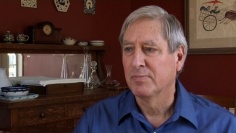LAURENCE REES: Auschwitz, of course, has a very particular place in all this, because it is almost the bridge between these concentration camps in the Thirties and the death camps, because it merges aspects of both, doesn’t it?
CHRISTOPHER BROWNING: Well, it’s a hybrid in the sense that it is a concentration camp which becomes a huge labour camp and also becomes a death camp. So all three main functions of the camp system are combined in one. It starts out as a concentration camp for Polish political prisoners. When Himmler makes his deals for the German industrialists to come and build factories there it becomes a huge labour camp. Birkenau initially is built for a hundred thousand Soviet prisoners of war who are to be slave labour, but they never show-up - a small number are sent but they die almost immediately. So it’s available to bring in Jews and then in three stages they turn it into a death camp. Initially we know that in September there were a couple of tests with the Zyklon B, and that the crematorium in the whole camp, the main camp – Auschwitz – then is used periodically to kill prisoners weeded out of the local labour camps in Silesia that are sent there, because they’ve been worked to the point that they’re not productive any more. Some are shot, some are gassed, and all that happens in the Fall of 1941. In the spring of 1942 they move things to Birkenau where two peasant huts are sealed up, bunkers one and two, and March - particularly for the big deportations from Silesia in May - is the beginning of the first mass killings.
The Slovakian Jews start coming in a little earlier, and then of course in the summer you have a second bunker on line and the Dutch, French and Belgian Jews begin to arrive. And then Himmler comes that summer and witnesses some of this and gives the approval to take the design of the gas chamber that had been designed back in October of 1941 for the old camp, which in the blueprints has been moved to Birkenau in February of 1942, for four other gas chambers. And they come on line in the spring of 1943. And Auschwitz then becomes the key place for where Jews from the other parts of Europe are sent. Some are still sent to Treblinka and Sobibor, but almost all the transports of Western, Southern and Central Europe go to Auschwitz.
Auschwitz
Professor Christopher Browning

- Anti-Semitism in Germany
- Hitler’s ideology about the Jews
- Concentration Camps
- Hitler’s Reichstag speech
- Himmler's actions
- The Ghettos
- The Nazis’ priorities
- Inhumanity of the Holocaust
- Invasion of the Soviet Union
- Hitler and the 'Final Solution'
- Killing Experiments
- The importance of October '41
- December and the 'Final Solution'
- The Death Camps
- Auschwitz
- 'Ordinary men'
- Lessons from the Holocaust
- Most important turning point in WW2
- Why study history and WW2
 Twitter
Twitter




